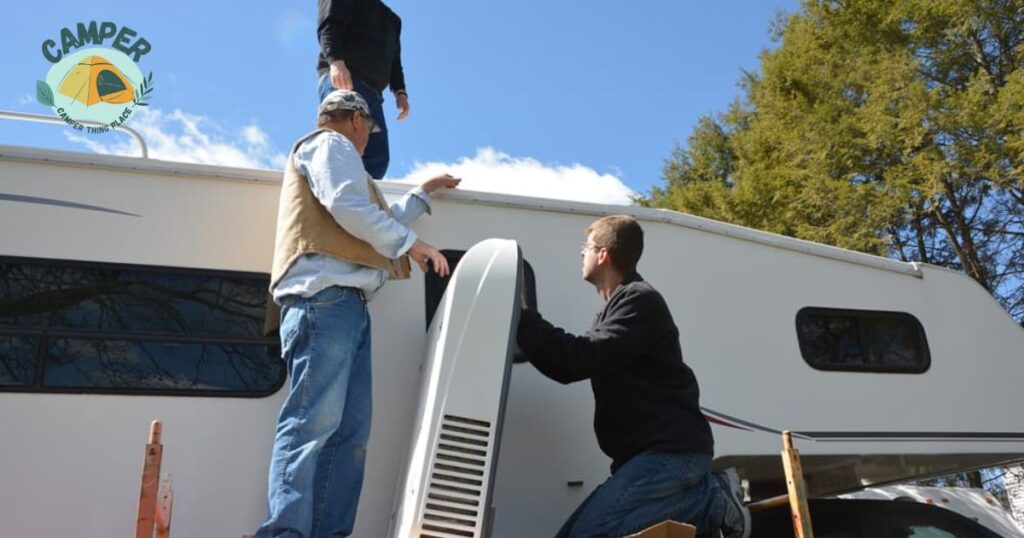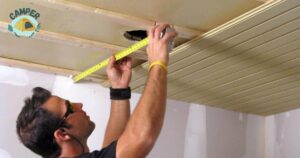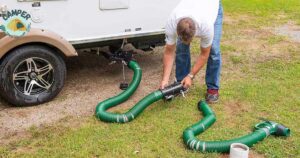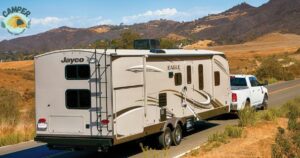Resealing a camper roof involves applying a protective coating to prevent leaks. Costs depend on factors like camper size, sealant type, and labor charges. Regular resealing ensures a watertight seal, extending the roof’s lifecycle.
It involves applying a protective shield against leaks, with expenses varying based on factors like camper size and sealant choice. Some people ask how much it costs to reseal a camper roof. Expose the value in every dollar spent as regular resealing not only safeguards against potential damage but also extends your camper roof’s life, ensuring worry-free adventures.
The cost to reseal a camper roof depends on factors such as the camper’s size, type of sealant, and labor charges. On average, it can range from a few hundred to over a thousand dollars. This investment is crucial for preventing leaks, protecting against damage, and ensuring the longevity of your camper roof. Regular resealing is a smart expense for a secure and durable outdoor travel experience.
What Is RV Roof Resealing?
RV roof resealing is a process to protect and maintain the roof of your recreational vehicle. It involves applying a special sealant to prevent leaks and damage caused by weather, UV rays, and other elements.
This sealant creates a watertight barrier, ensuring that your RV stays dry and free from potential water-related issues. Resealing is essential to extend the lifespan of your RV and avoid costly repairs. Regular maintenance, including roof resealing.
It helps to keep your vehicle in top condition, ensuring a comfortable and worry-free travel experience. By taking this preventive measure, you can enjoy your RV adventures without the concern of water damage and leaks.
Why It’s Necessary To Reseal An RV Roof?
Resealing an RV roof is crucial to prevent water damage and maintain the integrity of your vehicle, especially when trying to Stay Warm In A Tent On Cold Nights. Over time, exposure to the elements, UV rays, and harsh weather conditions can cause the roof sealant to deteriorate.
If left unchecked, this deterioration can lead to leaks, water intrusion, and potential structural damage. By regularly resealing the RV roof, you create a protective barrier that keeps water out, preserving the interior and preventing costly repairs.
It’s a preventive measure that safeguards your investment, ensuring a secure and dry environment inside your RV. No matter where your travels take you. Regular maintenance, including resealing, is key to enjoying a worry-free and comfortable journey in your home on wheels.
What to Consider Before Replacing A CamperRoof

Before deciding to replace an RV roof, consider the following factors:
- The extent of Damage: Assess the severity of the damage to your current roof. If the issues are limited to a few spots and can be effectively repaired, replacement may not be necessary.
- Type of Roof Material: Different RVs have different roof materials, such as rubber, fiberglass, or aluminum. Understand the pros and cons of each material and choose one that fits your needs and budget.
- Budget Constraints: Roof replacement can be a significant investment. Evaluate your budget and explore different roofing options to find a solution that balances cost and quality.
- Professional Inspection: Have a professional RV technician inspect your roof. They can provide expert advice on whether replacement is necessary and suggest suitable roofing materials based on your RV’s specifications.
- Weight Considerations: Consider the weight of the new roof material. Ensure that the replacement doesn’t exceed the weight capacity of your RV, which could impact its performance and safety.
- DIY vs. Professional Installation: Roof replacement is a complex task. Assess your skills and experience to determine if you can handle it as a DIY project or if it’s best left to professionals who have the expertise and tools for a proper installation.
- Warranty: Check if the new roof material comes with a warranty. A warranty provides peace of mind and can be an indicator of the manufacturer’s confidence in the product’s durability.
By carefully considering these factors, you can make an informed decision about whether to proceed with replacing your RV roof and choose the most suitable option for your specific situation.
Types of RV Roofs And Their Pricing
These are some types of RV Roofs:
| Type | Material | Advantages | Considerations | Price |
| Rubber (EPDM) | Ethylene Propylene Diene Monomer | Lightweight, cost-effective, flexible, UV-resistant | Susceptible to tears, may require maintenance | Affordable |
| Fiberglass | Fiberglass-reinforced plastic | Durable, lightweight, low maintenance, UV-resistant | The potential for cracking can be more expensive | Moderate |
| Aluminum | Aluminum panels or sheets | Lightweight, corrosion-resistant, durable | May dent or scratch easily, less insulation | Moderate |
| TPO (Thermoplastic Olefin) | Thermoplastic compound | Lightweight, energy-efficient, UV and chemical-resistant | It may not be as durable as some other materials | Affordable |
| PVC (Polyvinyl Chloride) | Polyvinyl Chloride membrane | Durable, UV and chemical-resistant, energy-efficient | More expensive, and may require professional installation | Expensive |
| Composite | Combination of different materials | Combines strengths of various materials | Cost and performance vary based on composition | Varies |
The price of roof of these campers depends upon the quality and some other factors which we mentioned under the article
Cost to Replace an RV Roof
The cost of replacing an RV roof can vary based on factors such as the type of roof material, the size of the RV, and local labor rates. Different materials, such as rubber (EPDM), fiberglass, aluminum, TPO (Thermoplastic Olefin), and PVC (Polyvinyl Chloride), each come with their advantages and considerations.
The decision to replace a roof is often influenced by factors such as the extent of damage, the age of the existing roof, and the need for improved durability or insulation. To determine the most suitable option and estimate, it is advisable to consult with professional RV service centers or roofing specialists who can assess the specific requirements of the RV and provide tailored recommendations.
Factors That Determine the Cost of Resealing an RV Roof
These are the factors that determine the cost of resealing of RV Roof:
Roof Size and Type
The size and type of the RV roof impact resealing costs; larger roofs generally require more sealant. Different roof materials may have varying price points, contributing to overall expenses.
Type of Sealant
The choice of sealant influences costs, ranging from basic caulk to advanced formulations. Higher-quality sealants may have a higher price but offer enhanced durability and protection against the elements.
Labor Costs
Labor expenses depend on the complexity of the resealing job and local labor rates. Professional services may charge hourly or provide fixed-rate estimates, affecting the overall cost.
Preparation and Cleaning
Thorough preparation, including cleaning and removal of old sealant, is critical. Additional work in this phase can contribute to the overall resealing cost.
Roof Condition
The existing roof’s condition influences costs; extensive damage or repairs before resealing may add to the overall expense.
Sealant Quality
The quality of the sealant used impacts costs; higher-quality sealants may be pricier but provide better, longer-lasting protection.
DIY vs. Professional Services:
Choosing DIY resealing may save on labor costs but requires purchasing tools and materials. Professional services, while costlier, ensure expertly executed and thorough resealing.
Additional Materials:
Depending on the resealing requirements, additional materials such as primer or reinforcement may be necessary, contributing to costs.
Location
Regional variations in costs of living and labor rates can influence resealing expenses for an RV roof. Local factors contribute to the overall cost estimation.
Considering these factors and obtaining estimates from professional service providers can help RV owners plan for the cost of resealing based on their specific needs and circumstances.
DIY vs Professional Installation
| Aspect | DIY Installation | Professional Installation |
| Skill and Experience | Requires a certain level of skill and experience in RV maintenance and resealing techniques. | Professionals typically have extensive experience and training, ensuring a high level of expertise. |
| Cost | Generally lower cost as you only pay for materials and tools. | Higher cost due to labor fees, but may include a warranty and professional guarantee. |
| Time Commitment | May take longer, especially for those less experienced. | Typically faster as professionals are well-trained and equipped for efficient work. |
| Quality of Work | Quality depends on individual skills; results may vary. | Consistent and high-quality work with professional standards. |
| Tools and Equipment | Requires purchasing or renting tools and equipment. | Professionals come with specialized tools, reducing the need for additional expenses. |
| Warranty and Guarantee | Limited or no warranty unless provided by the sealant manufacturer. | Often comes with a warranty on labor and sometimes materials, providing added protection. |
| Risk of Mistakes | Higher risk of mistakes or improper application. | Lower risk as professionals are trained to avoid common mistakes and ensure proper sealing. |
| Time and Convenience | Flexible scheduling, but may require more time and effort. | Offers convenience with a scheduled and efficient process, saving the owner time and effort. |
Deciding between DIY and professional installation depends on individual skills, time availability, budget considerations, and the desired level of expertise and guarantee.
Resealing or Coating, Which One Does Your RV Need?
Deciding between resealing or coating your camper depends on its condition. If your RV has leaks or worn seals, resealing is crucial. Resealing involves fixing specific areas to prevent water damage.
On the other hand, if your camper’s exterior is fading or lacks protection, coating might be the solution. Coating provides a new layer for UV protection and adds a fresh look. Assess your RV’s needs – resealing for leaks, or coating for overall protection and aesthetics.
What Are The Benefits Of Resealing An RV Roof?
Resealing an RV roof offers several important benefits, contributing to the overall maintenance and longevity of your recreational vehicle:
Leak Prevention
The primary purpose of resealing is to prevent water leaks. Resealing helps maintain the integrity of the roof, sealing any cracks or gaps that could allow water to penetrate and cause damage to the interior of the RV.
Water Damage Avoidance
By preventing leaks, resealing helps to avoid costly water damage. Water infiltration can lead to rot, mildew, and other structural issues within the RV, which can be expensive and challenging to repair.
Extended Roof Lifespan
Regular resealing contributes to the extended lifespan of the RV roof. It acts as a protective barrier against the elements, including sun exposure, preventing premature deterioration and aging of the roofing materials.
Preservation of Interior

A well-sealed roof protects the interior of the RV from potential water damage. This preservation is crucial for maintaining the aesthetics, functionality, and value of the vehicle.
Cost Savings in the Long Run
While resealing requires an initial investment of time and materials, it is a cost-effective preventive measure. It helps avoid the need for extensive and expensive repairs that may arise from water damage and other related issues.
Peace of Mind
Regularly resealing the RV roof provides peace of mind for owners. Knowing that the roof is well-protected against potential leaks and damage allows for a more enjoyable and worry-free RV experience.
Resealing an RV roof is a proactive maintenance step that offers a range of benefits, from preventing water damage and mold growth to extending the overall lifespan of the vehicle. Regular inspections and timely resealing contribute to the sustained performance and value of your RV.
How Often Should You Reseal Your RV Roof?
Routine maintenance of your RV roof is crucial to prevent water damage and ensure the longevity of your vehicle. As a general guideline, it’s recommended to inspect and reseal your RV roof at least once a year.
Factors such as the roof material, climate conditions, usage frequency, and the age of the RV can influence the optimal resealing schedule.
Regular visual inspections, prompt repairs of any identified issues, and adherence to manufacturer recommendations will contribute to a well-maintained roof, offering protection against leaks and preserving the overall condition of your RV.
Is the Cost of Resealing an RV Roof Worth It?
Maintaining your RV roof is essential, but is the cost to reseal it worth it? The answer depends on various factors. If your RV roof has visible leaks or cracks, investing in resealing can prevent further damage and save you money in the long run.
Regular resealing also extends the roof’s lifespan, protecting your investment and ensuring a comfortable and leak-free travel experience. However, if your RV roof is relatively new and in good condition, the cost may seem unnecessary
Consider factors like the age of your RV, your travel frequency, and the climate conditions it faces. If you plan to keep your RV for an extended period and use it frequently, the cost to reseal may be a wise investment.
On the other hand, if you’re a casual traveler or have a newer RV, spending money on resealing might not be as urgent. Ultimately, the decision to reseal an RV roof depends on your specific situation and how much value you place on the long-term protection and durability of your recreational vehicle.
Importance of considering long-term savings versus upfront costs
Considering long-term savings versus upfront costs is crucial for making wise financial decisions. While upfront costs may seem higher, evaluating the long-term benefits can reveal significant savings.
Investing in quality products or services upfront may incur a higher initial expense, but it often leads to reduced maintenance and replacement costs over time. Additionally, considering energy efficiency in major purchases can result in lower utility bills and fewer replacements.
Overall, prioritizing long-term savings over immediate costs promotes financial prudence and ensures a more sustainable and economically sound approach to decision-making.
Benefits derived from a properly sealed roof in terms of preventing damage

A properly sealed roof plays a pivotal role in preventing damage. It acts as a robust shield against water infiltration, protecting the interior from potential leaks and water-related issues. It also serves as a barrier against the damaging effects of prolonged exposure to the sun.
Thereby extending the lifespan of the roofing material. Additionally, a well-sealed roof acts as a defense against pests, insects, and the growth of mold or mildew, contributing to the overall structural integrity and creating a healthier environment within the building.
In essence, the benefits of a properly sealed roof encompass both longevity and the preservation of a safe and sound living or working space.
Impact on resale value
A well-maintained roof significantly elevates the resale value and marketability of an RV. Prospective buyers prioritize the condition of the roof as a key indicator of overall vehicle health, making a properly cared-for roof a valuable asset.
This proactive maintenance not only assures buyers of the RV’s durability and reliability but also distinguishes it in a competitive market. A sound roof becomes a compelling selling point, instilling confidence in potential buyers and contributing to a higher resale value, ultimately making the RV more attractive and market-ready.
Tips for Cost Savings
To save on camper roof resealing costs, consider a do-it-yourself (DIY) approach. Start by regularly inspecting your camper roof for minor issues, such as cracks or loose seals. Addressing these early can prevent major damage and costly repairs.
When opting for DIY resealing, purchase quality sealant and tools, and follow step-by-step guides available online. This not only reduces labor costs but also empowers you to maintain your camper efficiently. Additionally, explore local prices for materials and compare quotes from professional services.
Sometimes, hiring local professionals can be more cost-effective than larger companies. Keep in mind that preventive maintenance, like cleaning and applying sealant before significant issues arise, can be the most budget-friendly strategy in the long run.
Proper maintenance to prevent extensive damage
Proactive camper roof maintenance is essential to prevent extensive damage. Regularly inspect for wear, cracks, and loose seals, addressing small issues promptly to avoid costly problems. Water stain monitoring inside the camper can help catch leaks early.
Routine cleaning, removing dirt and debris, is crucial to prevent roof material deterioration. Apply a quality sealant for added protection against the elements. By investing time in these simple tasks, you can extend your camper roof’s lifespan and avoid hefty repair expenses.
DIY Tips for Cost-Effective Resealing
- Begin by inspecting the entire camper roof carefully. Identify areas with damaged sealant, cracks, or potential leaks. Addressing these issues early on can prevent more extensive damage later.
- Invest in a high-quality sealant specifically designed for your camper’s roof material. This ensures better adhesion and durability, reducing the likelihood of frequent resealing.
- Clean the roof surface thoroughly before applying the sealant. Remove dirt, debris, and old sealant using appropriate cleaners. A clean surface ensures better adhesion and longevity of the new sealant.
- Explore camper roof resealing kits available in the market. These often come with all the necessary materials and detailed instructions, making the process more straightforward for DIY enthusiasts.
- Use appropriate safety gear, including gloves and safety glasses, when working with sealants and cleaning agents. Ensure proper ventilation in the area to avoid inhalation of fumes.
- Rushing the resealing process can lead to mistakes. Take your time to apply the sealant evenly and allow it to cure properly. Follow the recommended drying times for optimal results.
- After resealing, incorporate regular maintenance into your routine. Periodic checks and small touch-ups can prevent major issues and extend the lifespan of the sealant.
By following these DIY tips, you can effectively reseal your camper roof while keeping costs down and ensuring the longevity of the sealing job.
Frequently Asked Questions
What can I use to reseal my camper roof?
You can use a specialized RV roof sealant, such as decor lap sealant or Eterna Bond tape, to effectively reseal your camper roof.
Does the camper size affect the resealing cost?
Yes, smaller campers cost $300-$800, while larger ones may range from $800 to $1,500 for resealing
What factors influence the cost of resealing a camper roof?
The cost varies based on factors like camper size, materials, repairs needed, labor, and geographic location.
Can insurance cover resealing costs?
In some cases, insurance may cover roof damage repairs, depending on policy specifics and deductibles.
How much does it cost on average to reseal a camper roof?
The average cost to reseal a camper roof ranges from $300 to $1,500, considering various influencing factors
Final Thoughts
The cost of resealing a camper roof can vary based on factors such as the size of the camper, the type of roofing material, and the extent of damage. On average, the expense ranges from $300 to $1,500, but it is essential to obtain accurate quotes from professionals to get a precise estimate for your specific situation.
The price of resealing can vary depending upon many factors. But we little we solve this question of how much it costs to reseal a camper roof. Investing in timely roof maintenance and resealing is crucial to prevent more extensive and expensive repairs down the road.
While the initial cost may seem significant, it serves as a cost-effective measure in the long run, ensuring the longevity of your camper and protecting it from potential water damage. Regular upkeep not only extends the life of your camper but also provides peace of mind during your travels.

Jackson Ray, a seasoned blogger with a decade of experience, is the creative mind behind “camperthingsplace.com.” Explore his wealth of insights and passion for camping through engaging content on the website.











